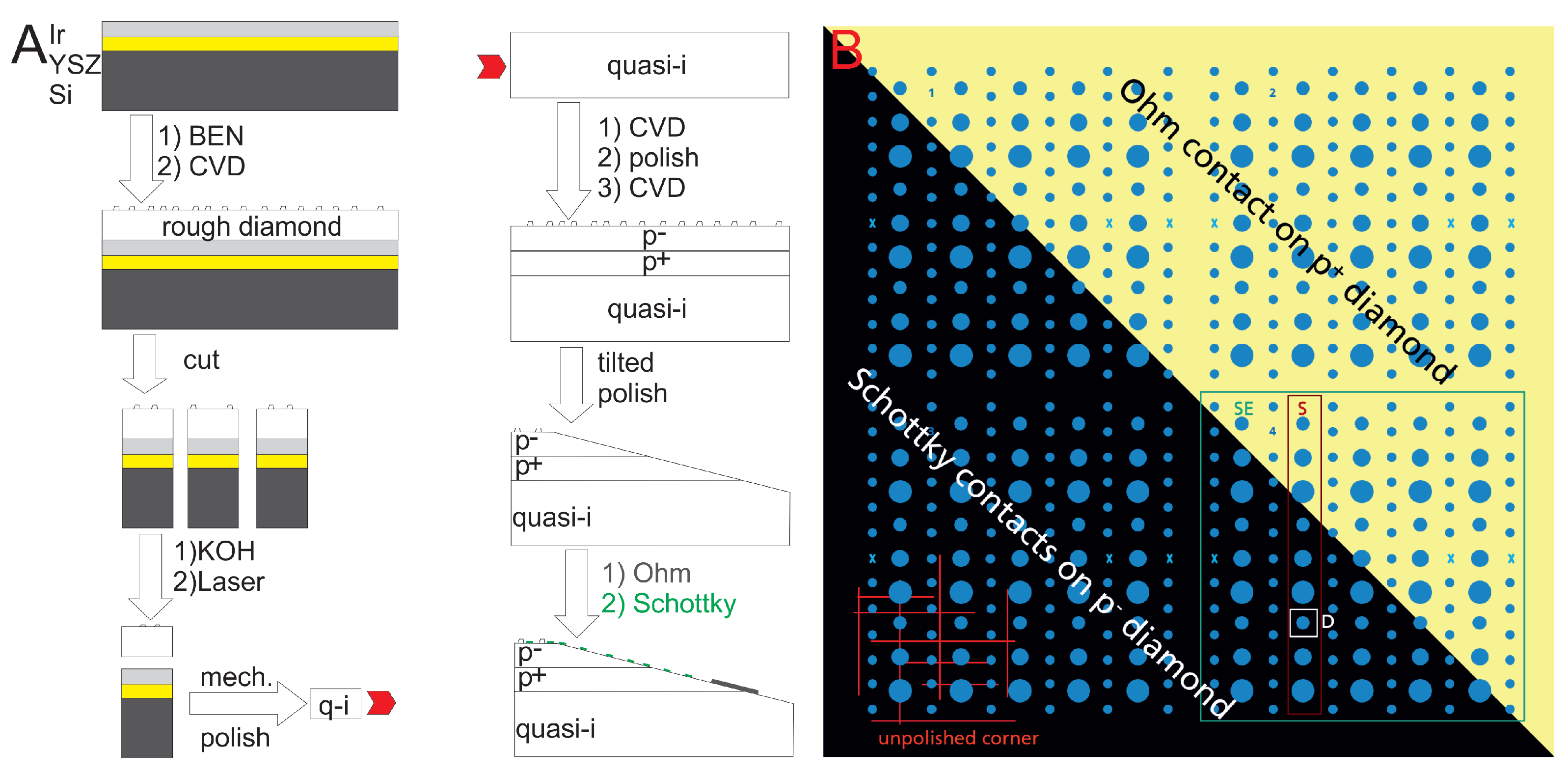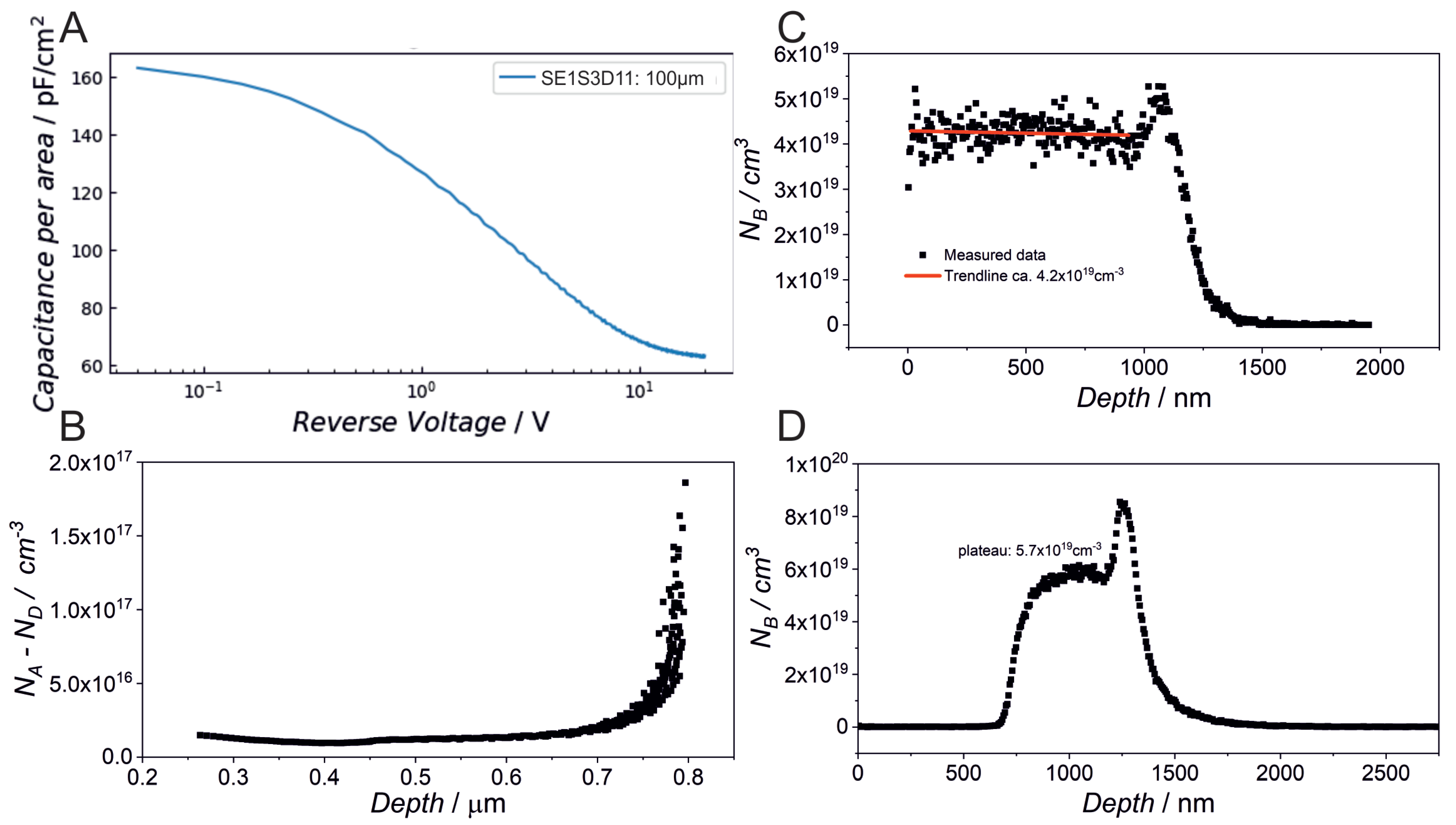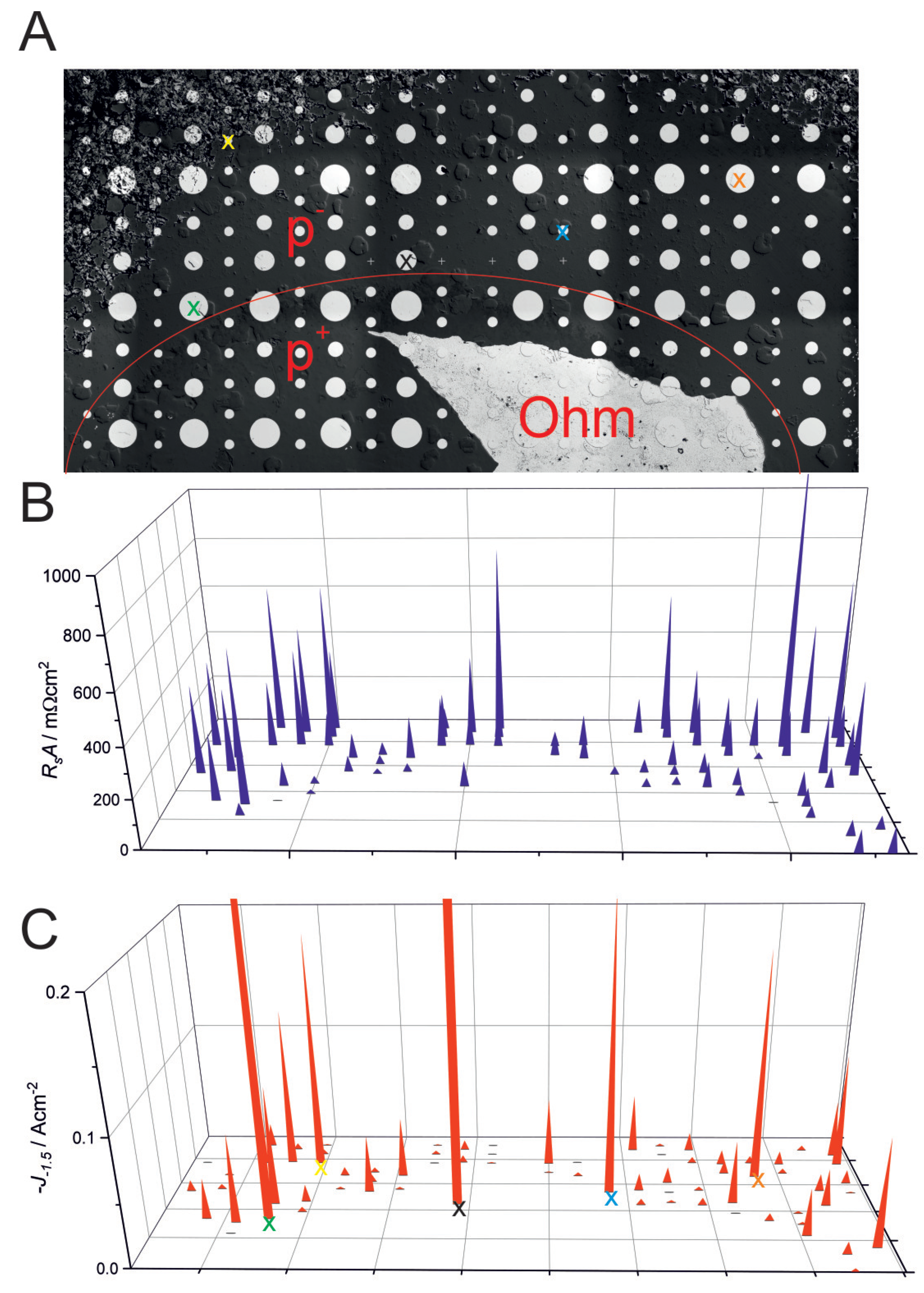Pseudovertical Schottky Diodes on Heteroepitaxially Grown Diamond
Abstract
1. Introduction
2. Materials and Methods
3. Results and Discussion
3.1. Determination of Dopant Concentrations
3.2. General Conducting Properties
4. Conclusions and Outlook
Author Contributions
Funding
Informed Consent Statement
Data Availability Statement
Acknowledgments
Conflicts of Interest
Abbreviations
| BDD | Boron-Doped Diamond |
| BEN | Bias Enhanced Nucleation |
| BFOM | Baliga Figure of Merit |
| CV | Capacitance–Voltage |
| CVD | Chemical Vapor Deposition |
| HPHT | High-Pressure–High-Temperature |
| MDPI | Multidisciplinary Digital Publishing Institute |
| MPCVD | Microwave Plasma CVD |
| SIMS | Secondary Ion Mass Spectrometry |
| TEM | Thermionic Emission |
References
- Araujo, D.; Suzuki, M.; Lloret, F.; Alba, G.; Villar, P. Diamond for electronics: Materials, processing and devices. Materials 2021, 14, 7081. [Google Scholar] [CrossRef]
- Donato, N.; Rouger, N.; Pernot, J.; Longobardi, G.C.; Udrea, F. Diamond power devices: State of the art, modelling, figures of merit and future perspective. J. Phys. D. Appl. Phys. 2020, 53, 093001. [Google Scholar] [CrossRef]
- Perez, G.; Maréchal, A.; Chicot, G.; Lefranc, P.; Jeannin, P.O.; Eon, D.; Rouger, N.; Perez, G.; Maréchal, A.; Chicot, G.; et al. Diamond semiconductor performances in power electronics applications. Diam. Relat. Mater. 2020, 110, 108154. [Google Scholar] [CrossRef]
- Shikata, S. Single crystal diamond wafers for high power electronics. Diam. Relat. Mater. 2016, 65, 168–175. [Google Scholar] [CrossRef]
- Gerrer, T.; Czap, H.; Maier, T.; Benkhelifa, F.; Müller, S.; Nebel, C.E.; Waltereit, P.; Quay, R.; Cimalla, V. 3 GHz RF measurements of AlGaN/GaN transistors transferred from silicon substrates onto single crystalline diamond. AIP Adv. 2019, 9, 125106. [Google Scholar] [CrossRef]
- Tarelkin, S.; Bormashov, V.; Buga, S.G.; Volkov, A.; Teteruk, D.; Kornilov, N.; Kuznetsov, M.; Terentiev, S.; Golovanov, A.; Blank, V. Power diamond vertical Schottky barrier diode with 10 A forward current. Phys. Status Solidi A 2015, 212, 2621–2627. [Google Scholar] [CrossRef]
- Zhao, D.; Liu, Z.; Wang, J.; Yi, W.; Wang, R.; Wang, K.; Wang, H. Performance Improved Vertical Diamond Schottky Barrier Diode with Fluorination-Termination Structure. IEEE Electron Device Lett. 2019, 40, 1229–1232. [Google Scholar] [CrossRef]
- Murooka, T.; Yaita, J.; Makino, T.; Ogura, M.; Kato, H.; Yamasaki, S.; Natal, M.; Saddow, S.E.; Iwasaki, T.; Hatano, M. Characterization of Schottky Barrier Diodes on Heteroepitaxial Diamond on 3C-SiC/Si Substrates. IEEE Trans. Electron Devices 2020, 67, 212–216. [Google Scholar] [CrossRef]
- Arnault, J.C.; Lee, K.; Delchevalrie, J.; Penuelas, J.; Mehmel, L.; Brinza, O.; Temgoua, S.; Stenger, I.; Letellier, J.; Saint-girons, G.; et al. Epitaxial diamond on Ir / SrTiO 3 / Si(001): From sequential material characterizations to fabrication of lateral Schottky diodes. Diam. Relat. Mater. 2020, 105, 107768. [Google Scholar] [CrossRef]
- Reinke, P.; Benkhelifa, F.; Kirste, L.; Czap, H.; Pinti, L.; Zurbig, V.; Cimalla, V.; Nebel, C.; Ambacher, O. Influence of Different Surface Morphologies on the Performance of High-Voltage, Low-Resistance Diamond Schottky Diodes. IEEE Trans. Electron Devices 2020, 67, 2471–2477. [Google Scholar] [CrossRef]
- Kawarada, H.; Yamada, T.; Xu, D.; Tsuboi, H.; Saito, T.; Hiraiwa, A. Wide temperature (10K-700K) and high voltage (1000V) operation of C-H diamond MOSFETs for power electronics application. In Proceedings of the 2014 IEEE International Electron Devices Meeting, San Francisco, CA, USA, 15–17 December 2014; pp. 11.2.1–11.2.4. [Google Scholar] [CrossRef]
- Masante, C.; Rouger, N.; Pernot, J. Recent progress in deep-depletion diamond metal – oxide – semiconductor field-effect transistors. J. Phys. D. Appl. Phys. 2021, 54, 233002. [Google Scholar] [CrossRef]
- Alhasani, R.; Yabe, T.; Iyama, Y.; Oi, N.; Imanishi, S.; Nguyen, Q.N.; Kawarada, H. An enhanced two-dimensional hole gas (2DHG) C–H diamond with positive surface charge model for advanced normally-off MOSFET devices. Sci. Rep. 2022, 12, 4203. [Google Scholar] [CrossRef] [PubMed]
- Hatano, M.; Iwasaki, T.; Yamasaki, S.; Makino, T. Diamond electronics. In Proceedings of the 46th European Solid-State Device Research Conference, Lausanne, Switzerland, 2–15 September 2016; pp. 330–332. [Google Scholar] [CrossRef]
- Iwasaki, T.; Hoshino, Y.; Tsuzuki, K.; Kato, H.; Makino, T.; Ogura, M.; Takeuchi, D.; Matsumoto, T.; Okushi, H.; Yamasaki, S.; et al. Diamond junction field-effect transistors with selectively grown n+-side gates. Appl. Phys. Express 2012, 5, 091301. [Google Scholar] [CrossRef]
- Takeuchi, D.; Koizumi, S.; Makino, T.; Kato, H.; Ogura, M.; Ohashi, H.; Okushi, H.; Yamasaki, S. Negative electron affinity of diamond and its application to high voltage vacuum power switches. Phys. Status Solidi A 2013, 210, 1961–1975. [Google Scholar] [CrossRef]
- Zhu, X.; Liu, J.; Shao, S.; Tu, J.; Huang, Y.; Bi, T.; Chen, L.; Wei, J.; Kawarada, H.; Li, C. Evolution of growth characteristics around the junction in the mosaic diamond. Diam. Relat. Mater. 2021, 120, 108640. [Google Scholar] [CrossRef]
- Ando, Y.; Sawabe, A. Heteroepitaxy of Diamond. In Physics and Applications of CVD Diamond; Koizumi, S., Nebel, C.E., Nesladek, M., Eds.; Wiley-VCH: Berlin, Germany, 2008; Chapter 4; pp. 77–92. [Google Scholar] [CrossRef]
- Schreck, M.; Gsell, S.; Brescia, R.; Fischer, M. Ion bombardment induced buried lateral growth: The key mechanism for the synthesis of single crystal diamond wafers. Sci. Rep. 2017, 7, 44462. [Google Scholar] [CrossRef] [PubMed]
- Kawashima, H.; Noguchi, H.; Matsumoto, T.; Kato, H.; Ogura, M.; Makino, T.; Shirai, S.; Takeuchi, D.; Yamasaki, S. Electronic properties of diamond Schottky barrier diodes fabricated on silicon-based heteroepitaxially grown diamond substrates. Appl. Phys. Express 2015, 8, 104103. [Google Scholar] [CrossRef]
- Kwak, T.; Lee, J.; Choi, U.; So, B.; Yoo, G.; Kim, S.; Nam, O. Diamond Schottky barrier diodes fabricated on sapphire-based freestanding heteroepitaxial diamond substrate. Diam. Relat. Mater. 2021, 114, 108335. [Google Scholar] [CrossRef]
- Sittimart, P.; Ohmagari, S.; Yoshitake, T. Enhanced in-plane uniformity and breakdown strength of diamond Schottky barrier diodes fabricated on heteroepitaxial substrates. Jpn. J. Appl. Phys. 2021, 60. [Google Scholar] [CrossRef]
- Gsell, S.; Bauer, T.; Goldfuß, J.; Schreck, M.; Stritzker, B. A route to diamond wafers by epitaxial deposition on silicon via iridium/yttria-stabilized zirconia buffer layers. Appl. Phys. Lett. 2004, 84, 4541–4543. [Google Scholar] [CrossRef]
- Yoshikawa, T.; Kodama, H.; Kono, S.; Suzuki, K.; Sawabe, A. Wafer bowing control of free-standing heteroepitaxial diamond (100) films grown on Ir(100) substrates via patterned nucleation growth. Thin Solid Films 2015, 594A, 120–128. [Google Scholar] [CrossRef]
- Lebedev, V.; Engels, J.; Kustermann, J.; Weippert, J.; Cimalla, V.; Kirste, L.; Giese, C.; Quellmalz, P.; Graff, A.; Meyer, F.; et al. Growth Defects in Heteroepitaxial Diamond. J. Appl. Phys. 2021, 129, 165301. [Google Scholar] [CrossRef]
- Schreck, M.; Mayr, M.; Klein, O.; Fischer, M.; Gsell, S.; Sartori, A.F.; Gallheber, B.C. Multiple role of dislocations in the heteroepitaxial growth of diamond: A brief review. Phys. Status Solidi A 2016, 213, 2028–2035. [Google Scholar] [CrossRef]
- Beshenkov, V.G.; Znamenskii, A.G.; Marchenko, V.A.; Pustovit, A.N.; Chernykh, A.V. Extension of the temperature range of epitaxial YSZ film growth on Si(100) during magnetron sputtering. Tech. Phys. 2007, 52, 636–641. [Google Scholar] [CrossRef]
- Yoshikawa, T.; Herrling, D.; Meyer, F.; Burmeister, F.; Nebel, C.E.; Ambacher, O.; Lebedev, V. Influence of substrate holder configurations on bias enhanced nucleation area for diamond heteroepitaxy: Toward wafer-scale single-crystalline diamond synthesis. J. Vac. Sci. Technol. B 2019, 37, 021207. [Google Scholar] [CrossRef]
- Füner, M.; Wild, C.; Koidl, P. Novel microwave plasma reactor for diamond synthesis. Appl. Phys. Lett. 1998, 72, 1149–1151. [Google Scholar] [CrossRef]
- Rhoderick, E.H.; Williams, R.H. The capacitance of a Schottky Barrier. In Met. Contacts, 2nd ed.; Hammond, P., Grimsdale, R., Eds.; Oxford University Press: New York City, NY, USA, 1988; pp. 141–181. [Google Scholar]
- Cordes, L.F.; Garfinkel, M. High voltage power Schottky diodes. In Proceedings of the IEEE Power Electronics Specialists Conference, Murray Hill, NJ, USA, 10–12 June 1974; IEEE: Murray Hill, NJ, USA, 1974; pp. 205–213. [Google Scholar] [CrossRef]
- Blank, V.D.; Bormashov, V.S.; Tarelkin, S.A.; Buga, S.G.; Kuznetsov, M.S.; Teteruk, D.V.; Kornilov, N.V.; Terentiev, S.A.; Volkov, A.P. Power high-voltage and fast response Schottky barrier diamond diodes. Diam. Relat. Mater. 2015, 57, 32–36. [Google Scholar] [CrossRef]
- Tung, R.T. Recent advances in Schottky barrier concepts. Mater. Sci. Eng. R 2001, 35, 1–138. [Google Scholar] [CrossRef]
- Banwell, T.C.; Jayakumar, A. Exact analytical solution for current flow through diode with series resistance. Electron. Lett. 2000, 36, 291–292. [Google Scholar] [CrossRef]
- Jung, W.; Guziewicz, M. Schottky diode parameters extraction using Lambert W function. Mater. Sci. Eng. B Solid-State Mater. Adv. Technol. 2009, 165, 57–59. [Google Scholar] [CrossRef]
- Lebedev, V.; Yoshikawa, T.; Giese, C.; Kirste, L.; Žukauskaite, A.; Graff, A.; Meyer, F.; Burmeister, F.; Ambacher, O. Formation of icosahedron twins during initial stages of heteroepitaxial diamond nucleation and growth. J. Appl. Phys. 2019, 125, 075305. [Google Scholar] [CrossRef]
- Chiu, F.C. A Review on Conduction Mechanisms in Dielectric Films. Adv. Mater. Sci. Eng. 2014, 2014, 578168. [Google Scholar] [CrossRef]
- Child, C.D. Discharge from hot platinum wires. Phys. Rev. Ser. I 1911, 32, 492–511. [Google Scholar] [CrossRef]
- Baliga, B.J. Power Semiconductor Device Figure of Merit for High-Frequency Applications. IEEE Electron Device Lett. 1989, 10, 455–457. [Google Scholar] [CrossRef]





| Sample ID | N (cm) | N-N (cm) |
|---|---|---|
| I | 5 × | 1.4 × |
| II | 7 × | 8 × |
| III | 1 × | 5 × |
Publisher’s Note: MDPI stays neutral with regard to jurisdictional claims in published maps and institutional affiliations. |
© 2022 by the authors. Licensee MDPI, Basel, Switzerland. This article is an open access article distributed under the terms and conditions of the Creative Commons Attribution (CC BY) license (https://creativecommons.org/licenses/by/4.0/).
Share and Cite
Weippert, J.; Reinke, P.; Benkhelifa, F.; Czap, H.; Giese, C.; Kirste, L.; Straňák, P.; Kustermann, J.; Engels, J.; Lebedev, V. Pseudovertical Schottky Diodes on Heteroepitaxially Grown Diamond. Crystals 2022, 12, 1626. https://doi.org/10.3390/cryst12111626
Weippert J, Reinke P, Benkhelifa F, Czap H, Giese C, Kirste L, Straňák P, Kustermann J, Engels J, Lebedev V. Pseudovertical Schottky Diodes on Heteroepitaxially Grown Diamond. Crystals. 2022; 12(11):1626. https://doi.org/10.3390/cryst12111626
Chicago/Turabian StyleWeippert, Jürgen, Philipp Reinke, Fouad Benkhelifa, Heiko Czap, Christian Giese, Lutz Kirste, Patrik Straňák, Jan Kustermann, Jan Engels, and Vadim Lebedev. 2022. "Pseudovertical Schottky Diodes on Heteroepitaxially Grown Diamond" Crystals 12, no. 11: 1626. https://doi.org/10.3390/cryst12111626
APA StyleWeippert, J., Reinke, P., Benkhelifa, F., Czap, H., Giese, C., Kirste, L., Straňák, P., Kustermann, J., Engels, J., & Lebedev, V. (2022). Pseudovertical Schottky Diodes on Heteroepitaxially Grown Diamond. Crystals, 12(11), 1626. https://doi.org/10.3390/cryst12111626






